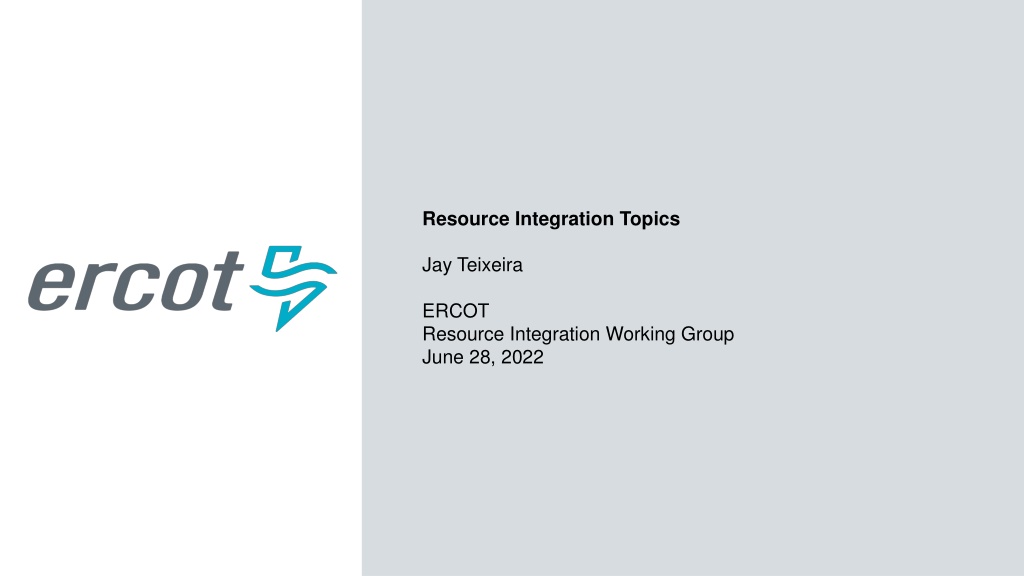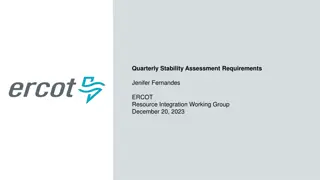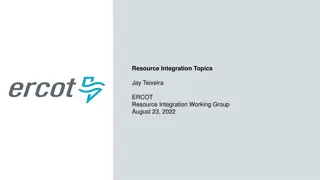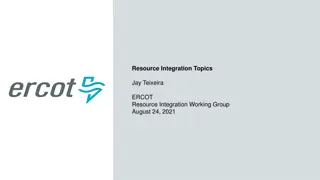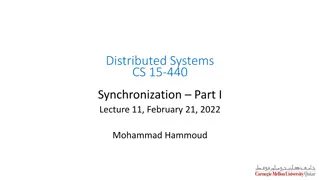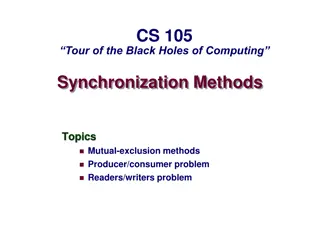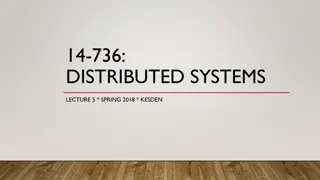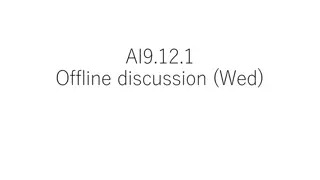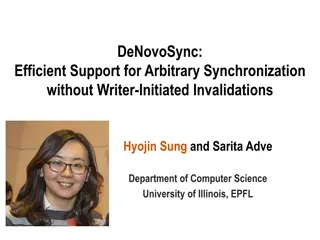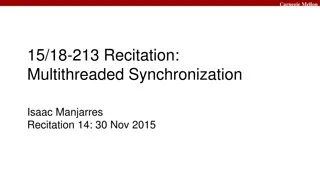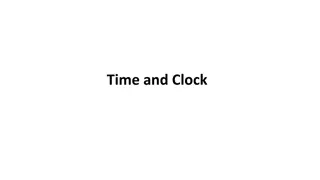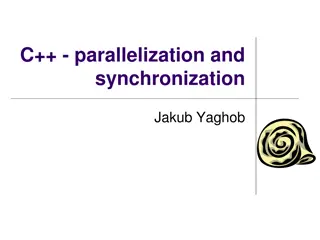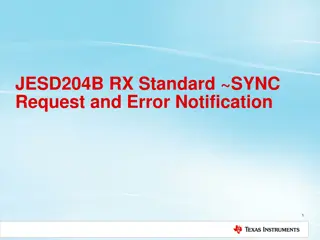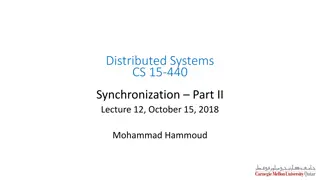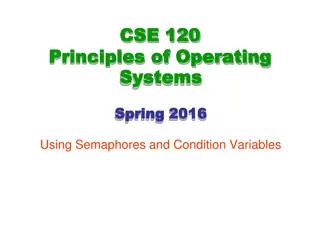Resource Integration Topics for Large Generation Projects: Planning and Synchronization
The resource integration topics discussed in the ERCOT Working Group cover Quarterly Stability Assessment (QSA) planning, synchronization dates, issues related to previous QSAs, and the process for large generation projects seeking simultaneous screening and full interconnection studies. Key deadlines and milestones are outlined for effective planning and coordination among involved parties.
Download Presentation

Please find below an Image/Link to download the presentation.
The content on the website is provided AS IS for your information and personal use only. It may not be sold, licensed, or shared on other websites without obtaining consent from the author. Download presentation by click this link. If you encounter any issues during the download, it is possible that the publisher has removed the file from their server.
E N D
Presentation Transcript
Resource Integration Topics Jay Teixeira ERCOT Resource Integration Working Group June 28, 2022
Quarterly Stability Assessment (QSA) Planning Guide 5.9 Next Deadline for QSA All-Inclusive Generation Resource Initial Synchronization Date Upcoming January, February, March Last Day for an IE to meet prerequisites as listed in paragraph (4) below Prior August 1 Completion of Quarterly Stability Assessment End of October Prior November 1 End of January Upcoming April, May, June Prior February 1 End of April Upcoming July, August, September Prior May 1 End of July Upcoming October, November, December If a GINR is not included in QSA, its Initial Synchronization date will be automatically delayed to the next quarter 2
Quarterly Stability Assessment (QSA) Planning Guide 5.9, Quarterly Stability Assessment Issue s seen in previous QSA s 10 day comment period for FIS Needs to be complete before QSA deadline TSPs need to plan for it Dynamic/PSCAD Model Review Dependent on FIS Stability study Need to meet PG 6.9 15 to 30 days prior to QSA deadline PSSE Model Quality Test Required PSCAD Model Quality Test and Unit Model Validation required TSAT Model Required If PSSE model is UDM, then TSAT model should be UDM 3
Current Process for Large Generation Project Wanting Simultaneous Screening Study and Full Interconnection Study (No Construction Bottleneck) 20 Months Assumptions IE submits correct data IE meets all milestones IE does not change equipment TSP has no backlog 6/21/2020 Part 1 Approval 2/1/2020 QSA Deadline 5/1/2020 QSA Complete 7/1/2020 Part 2 Approval Earliest Sync Based on QSA 7/1/2019 Reactive Study 4/1/2019 SS Complete 1/1/2019 6/1/2020 PLD* INR Request Initiated 9/1/2020 Part 3 Approval 1/1/2019 9/1/2020 TSP Complete FIS (10 months) Range 9 to 13 months Kick-Off -2 weeks Sign Study Scope months Received Payment 1 month SS Study months SC month Dynamic months Facility months ERCOT Approved 11/1/2019 - 2/1/2020 2/1/2020 - 6/1/2020 SGIA, NTP & Financial Commitment Days RARF Submission 7/1/2020 - 9/1/2020 2/1/2020 - 7/1/2020 Testing ~5 months SSR Study Completed and Approved *Interim updates are not allowed for new units. Interim update requests must be approved by ERCOT Network Modeling. Construction time for TSP to construct needed facilities not shown. Start of construction dependent on RE giving TSP Notice to Proceed and providing the Funding to construct the interconnection facilities. Length of time needed for construction depends on facilities being constructed. The PLD shown above is normally after completion of construction. 4
New Process for Small Generators TDSP Work Prior to RIOO Submittal (8 to 10 Months Timeline for Projects After the DGR Moratorium) 5/19/2022 Part 1 Approval 1/14/2022 Review required Submissions 1/31/2022 Registration RARF Approval 10/3/2021 Optional Small Gen Review Meeting 1/18/2022 Review RARF 5/31/2022 Part 2 Approval 1/4/2022 5/4/2022 PLD* 7/31/2022 Part 3 Approval Submit INR in RIOO 10/1/2021 8/1/2022 5/4/2022 - 7/31/2022 2/1/2022 - 5/1/2022 10/1/2021 - 1/1/2022 Commissioning Checklists & Testing Days RARF Submission (Prior to PLD) IE/RE Work with TDSP (IA, System Impact Studies, Interconnection Requirements, Operational Limitations, ETC) *Interim updates are not allowed for new units. Interim update requests must be approved by ERCOT Network Modeling. Construction time for TSP/DSP to construct needed facilities not shown. Start of construction dependent on RE giving TSP Notice to Proceed and providing the Funding to construct the interconnection facilities. Length of time needed for construction depends on facilities being constructed. The PLD shown above is normally after completion of construction. RE should have all TSP/DSP studies and IA complete before requesting the scoping meeting. 5
New Process for Small Generators RIOO Submittal Prior to TDSP Work (8 to 10 Months Timeline for Projects after DGR Moratorium) 8/27/2022 Part 1 Approval 4/30/2022 Registration RARF Approval 4/1/2022 1/9/2022 Optional Small Gen Review Meeting Submit required Submissions 4/14/2022 Review required Submissions 9/5/2022 Part 2 Approval 1/4/2022 8/3/2022 PLD* 4/18/2022 Review RARF Submit INR in RIOO 10/31/2022 Part 3 Approval 1/4/2022 11/1/2022 1/4/2022 - 4/1/2022 8/3/2022 - 11/1/2022 5/1/2022 - 8/1/2022 IE/RE Work with TDSP Commissioning Checklists & Testing Days RARF Submission (Prior to PLD) IE/RE Work with TDSP (IA, System Impact Studies, Interconnection Requirements, Operational Limitations, ETC) *Interim updates are not allowed for new units. Interim update requests must be approved by ERCOT Network Modeling. Construction time for TSP/DSP to construct needed facilities not shown. Start of construction dependent on RE giving TSP Notice to Proceed and providing the Funding to construct the interconnection facilities. Length of time needed for construction depends on facilities being constructed. The PLD shown above is normally after completion of construction. RE should have all TSP/DSP studies and IA complete before requesting the scoping meeting. 6
RI Handbook Update Resource Interconnection Handbook Updated Version 1.92, dated 6/15/2022 Market Notice Sent 6/21/2022 NOTICE DATE: 06/21/2022 NOTICE TYPE: W-A062122-01 Operations SHORT DESCRIPTION: Resource Interconnection Handbook posted INTENDED AUDIENCE: All Market Participants DAYS AFFECTED: June 21, 2022 LONG DESCRIPTION: An update to the Resource Interconnection Handbook has been posted on https://www.ercot.com/services/rq/integration. The new version is 1.92 dated 06/15/2022. 7
Use of current Commissioning Checklist ERCOT New Generator Commissioning Checklist Posted 2/21/2022 New submittals must use this version https://www.ercot.com/files/docs/2022/02/22/ERCOT%20New%20Generator%20 Commissioning%20Checklist.docx 8
BTM Load Requirements 1. The RE has provided ERCOT and the Interconnected TSP the technical equipment and load data to be used in modeling studies for the new netting loads being added. 2. Required system studies including new netting loads have been completed and approved by TSP and ERCOT. This includes any modifications to existing FIS studies or new studies that impact the system. 3. One of the following has been completed: a. Amendments to the SGIA indicating new netting loads have been signed by all three parties (TDSP, RE, Load Entity). The SGIA should reflect the servable load. OR b. Amendments to the SGIA indicating new netting loads has been signed by the TSP and RE and the TSP has submitted a written notification agreeing to proceed with the energization of the new load per the amended SGIA. OR c. Written notification from the TSP agreeing to proceed with the energization of the new load per the approved studies. 4. Reactive study with the addition of the new netting loads has been approved by ERCOT. For existing Resource not currently in the Interconnection process as a repower, the Reactive study can be submitted in RIOO-RS. 5. EPS Meter Proposal including the new netting loads has been approved by ERCOT. 6. Updated Resource Registration data that includes the addition of the PUN loads and any other topology changes at the Station. In addition, the Production Load Date that the Network Operations Model has been updated, including required telemetry. The current timeline to model the new netting load is a 90-day PLD. For additional information regarding the modeling schedule, please refer to the Production Load Schedule. Furthermore, the following prerequisites must be met prior to RARF approval to add the new PUN Load: a) Required system studies have been completed and approved. b) Meet one of the following requirements stated in item #3. c) Reactive study with the addition of the new netting load has been completed and approved. d) EPS meter proposal has been submitted and approved by ERCOT metering. e) Any request for Interim updates requires approval from ERCOT Modeling. 7. Checklist Part 1 to Energize the new netting loads and associated equipment has been submitted in RIOO-IS for Generation in the interconnection process or RIOO-RS for other generation. 9
Load Compliance Checklist Requirements for New Netting Loads Added to New or Existing Generation sites. Must be completed and submitted along with Part 1 Energization Checklist ERCOT New Generator Commissioning Checklist. RE is responsible for re-evaluating the Reactive study to assess the impact of the additional PUN load to ensure the Resource s ability to meet VSS requirements is not impacted. Example: 100MW Resource, VSS requirement is +/- 32.9 MVAr. Addition of 50MW PUN load consuming 4 MVAr s being connected to the MV bus. The Reactive study should demonstrate that the Resource is able to meet +/- 32.9MVAr with the additional 50MW load. 10
FIS Study for Co-located load Resource Entities adding large behind-the-meter loads to their facilities must coordinate with their interconnecting TSP and ERCOT on appropriate interconnection studies: Studies should follow all applicable guidelines: NERC FAC-002, NERC TPL 001-5, ERCOT Planning Guide Section 4. Study must include scenario with the Load online and Generation offline. Studies: Steady-state required Short circuit required or provide suitable justification Stability study- Most large loads will require a stability study. TSP will inform the load customer if no stability study is needed after careful consideration by TSP and ERCOT SSR if needed 11
Telemetry location for ESR MVAr Telemetry during Charging-Leading ESR MVAr telemetry during charging scenarios should be represented on the Unit. ESR Load MVAr should always be 0. Same sign convention as Unit MVAr. Load MVAr = 0 Load MW=Charging Unit Gross MW = 0 Unit Gross MVAr 12
Active RRs None 13
Other contact information ResourceIntegrationDepartment@ercot.com is distribution list for Resource Integration department Mailing List RESOURCE_INTEGRATION@LISTS.ERCOT.COM 14
Questions? Thank you!
